What to See in Vienna | Vienna Travel Guide
- Was man wissen muss, bevor man nach Wien kommt
- Wie man am besten nach Wien kommt
- Unterkünfte in Wien: die besten Möglichkeiten
- What to see in Vienna
- Verkehrsmittel in Wien
- Essen in Wien
- Abends unterwegs in Wien
- Wien und Umgebung: welche Städte man nicht verpassen darf
To write a comprehensive article about all the sights of Vienna is close to impossible. The Austrian capital has an incredible multitude of historic landmarks to offer that are well worth seeing and to name all of them in one article is a very hard task. Therefore, even though I will try my best to introduce Viennas highlights in a short summary, I'll have to leave out some of the less well-known places, even though they are no less unique and worth visiting.
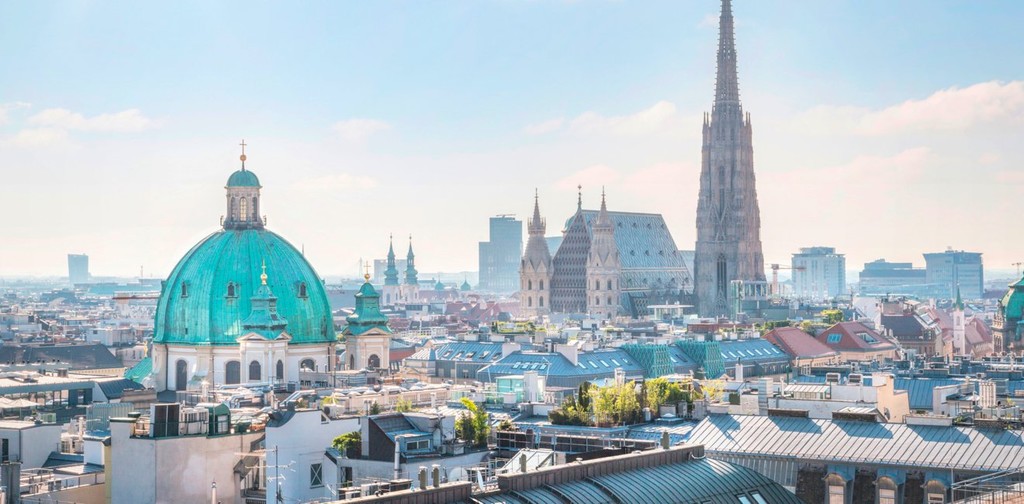
View across Vienna with the Karlskirche (left) and the Stephansdom (right)
I have prepared three different sightseeing tours for you, each of which takes an entire day of exploring by foot. This way, you don't have to worry about public transportation. This also means, that all tours focus on the city center. If you don't have a lot of time in Vienna (for example if you're there for a weekend trip), you can of course combine parts of the different tours however you like.
Most sights are right in the city center. Just for a couple of important addresses you might have to take the U-Bahn (the metro) or other means of transportation.
- Schönbrunn Palace: U4 Schönbrunn
- Tiergarten Schönbrunn: U4 Hietzing
- Prater: U1, U2 Praterstern, U2 Messe Prater
- Donauinsel: U1 Donauinsel, U2 Donaumarina. U6 Handelskai or Neue Donau
- Donauturm: U1 Alte Donau, U6 Neue Donau
- Ernst-Happel-Stadion: U2 Stadion
But now, let's get to our sightseeing tours! And as I said, each of the tours takes an entire day, if you want to take a good look at everything, so don't underestimate the agenda you set for yourself!
Tour 1: An Imperial Walk
Belvedere - Schwarzenbergplatz - Kärntner Straße - Stephansplatz - Graben - Hofburg
This monumental tour starts at Belvedere, the - once private - palace of Prince Eugene of Savoy. Today it is home to a number of state-run museums with many significant exhibits, among them some of the most famous paintings by Austrian symbolist painter Gustav Klimt. Start with the Upper Belvedere and walk past the spacious, well kept garden to the lower Belvedere. You can reach the starting point by S-Bahn or tram D. If you want, take some time to explore one of the galleries inside the palace, or simply look at the monumental building from the outside.
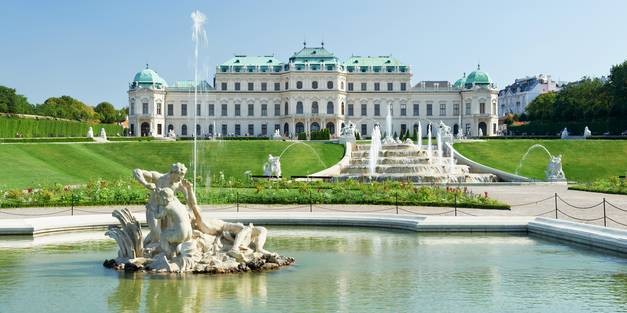
Upper Belvedere and its Ostentatious Gardens
You can leave the Lower Belvedere towards the Schwarzenbergplatz, where our tour continues. The giant fountain at the center of the large square is illuminated colourfully every night. Next to it, the Soviet War Memorial commemorates the soldiers killed during the Vienna Offensive in 1945. The square is a good place to sit down in the sun for a while (in case the weather is nice of course) and enjoy the view.
Next, we turn right to the Kärtner Ring (part of the famous Vienna Ring Road, built under the reign of Emperor Franz Joseph I. ). Here, you can marvel at some of the most exclusive and expensive hotels in the city. After a few minutes of walking, you reach the Vienna State Opera, where you turn right towards the Kärtner Straße, a large and rather famous shopping street. Follow this street until the end, taking some time to peek through the shop windows and take a look inside the countless stores full of fashion, jewellery, and souvenirs. The street leads you straight towards Stephansplatz, known as the "heart of Vienna" and the next stop of our little tour.
Once you have found your way to the square, you will find yourself right in front of the Stephansdom, one of Vienna's most important landmarks. You can enter the church free of charge and have a look around, buying a ticket is only necessary to climb up into the bell tower or down into the catacombs. However, both of these can also be very interesting (especially the catacombs are quite spine-chilling), so you should definitely consider putting up with the extra charge.
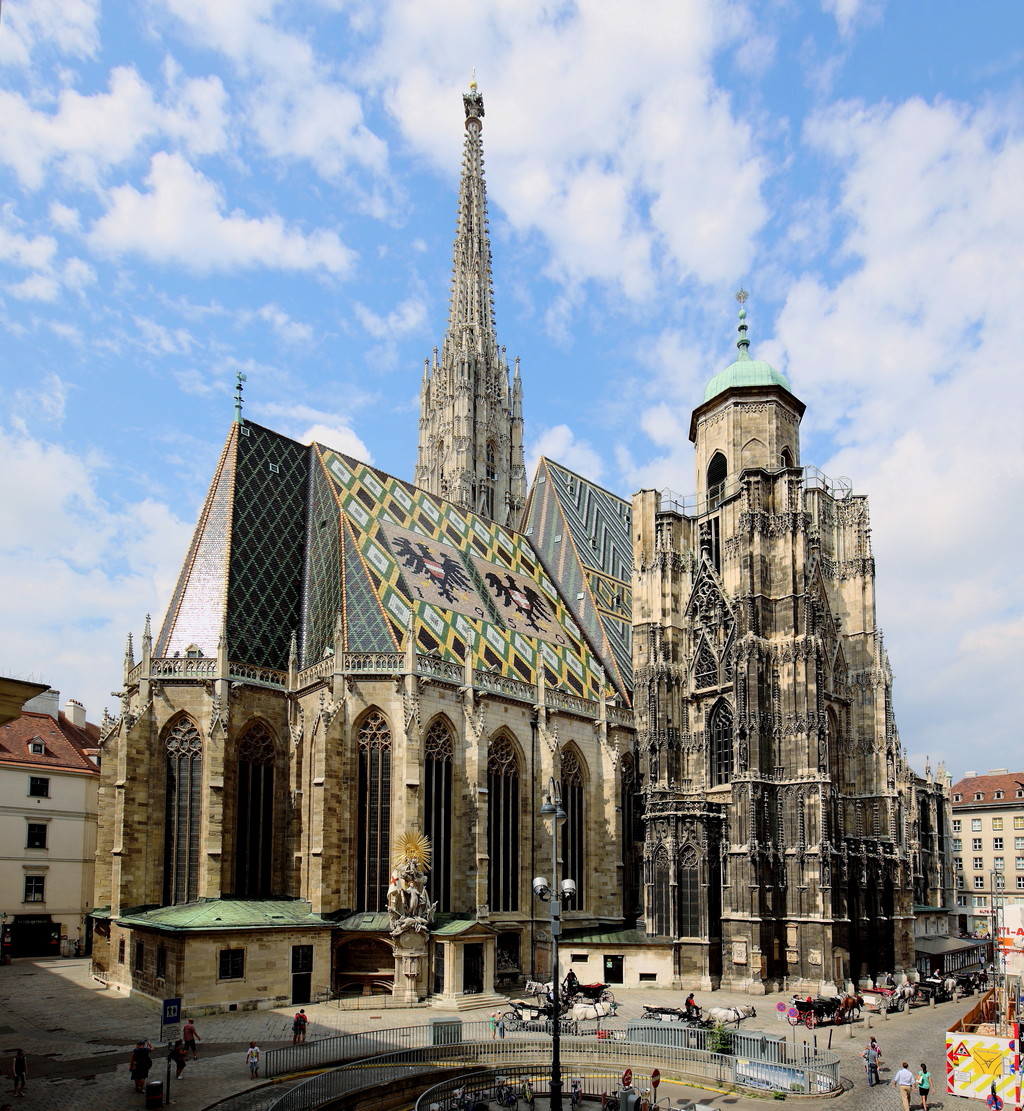
The Back Facade of the Stephansdom
Now walking across Stephansplatz again, leaving the church behind you, you simply walk straight (a little bit towards the left, past the Zara at the corner) and quickly reach the Graben (German for ditch, trench). Regardless of the rather strange name, this is just another shopping street with lots of nice coffee shops and cafés. The street's main attraction is the impressive golden Plague Column, a baroque trinity column, erected during the aftermath of a devastating plague epidemic in the city.
Keep walking until you reach the end of the street and turn left and keep going until you reach the back entrance of the Hofburg. To the left, you will see the Spanish Riding School, where horses of the famous and majestic white Lippizaner breed are trained in classical dressage. But instead, we are heading towards the Hofburg, the principal imperial palace of the Habsburg dynasty until the year 1918 and home to the magnificent Austrian National Library. The whole site is enormous and there is incredibly much to see so buy a ticket, take the rest of the day and explore the Hofburg!
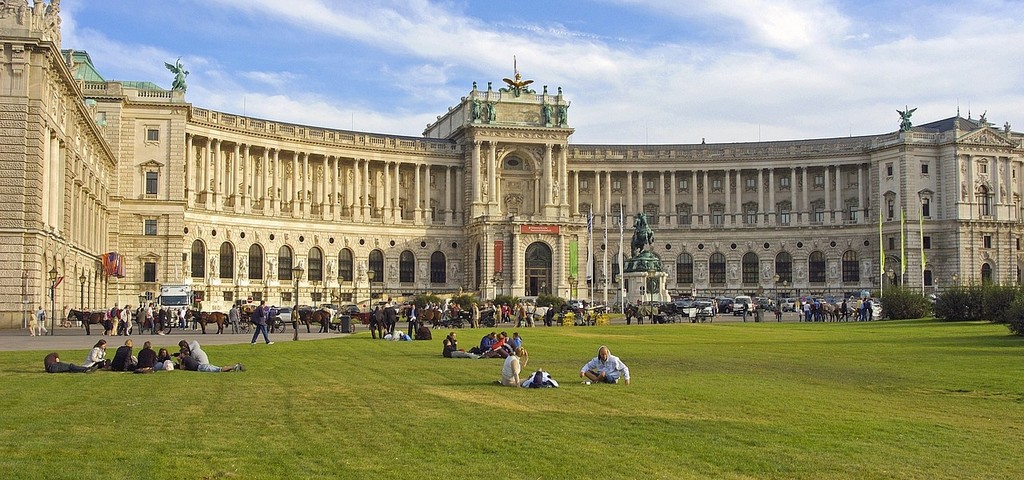
Tour 2: A Little Bit of Culture
Opera - Albertina - Museum of Art History and Natural History Museum - Museumsquartier - Mariahilfer Straße
All you have to do to find the starting point of our second tour is to take the U1, U2 or U4 to Karlsplatz. Just from the outside, the Vienna State Opera is built to impress, but all that is nothing compared to its inside. The Vienna State Opera is one of the world's most well-known and most highly renowned opera houses and opened its doors in 1869 with a performance of "Don Giovanni" by Mozart and Da Ponte. This beautiful site is also where the rich and famous (or as Austrians call them: The "Bussi-Bussi-Gesellschaft") meet every year for the glamorous Vienna Opera Ball.
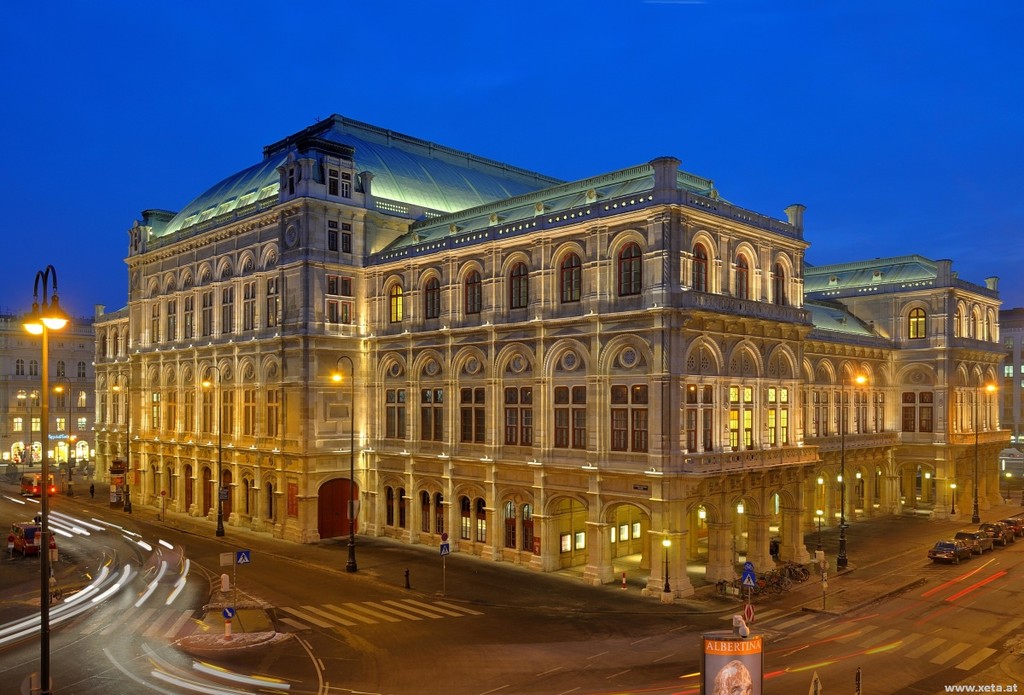
Next, the wonderful Albertina awaits us - a beautiful museum hiding right behind the opera. The Albertina is formally part of the Hofburg, even though it is situated in an entirely different building. This museum celebrates and teaches about modern art in frequently changing exhibitions. Even those who are not art historians will find something they like in the multitude of styles, epochs and artists whose work is displayed here, so that everyone can enjoy themselves walking through the halls and gazing at the paintings.
Our next stop is also a museum - or two, to be precise - so you can decide to go for the one that interests you most. The Museum of Art History and Natural History Museum are not far from the Albertina, right across the Maria-Theresien-Platz. The two identical buildings were built under the command of Emperor Franz Joseph I. , who needed an appropriate place to keep the court's collections of natural history objects as well as the paintings and treasures of the Habsburg dynasty. Especially the Museum of Art History is nowadays one of the most distinguished museums of Modern Art worldwide, showing everything from famous paintings to archeological artefacts and the imperial coin collection as well as its own library.

The Museum of Art History as seen from Maria-Theresien-Platz
In case you're not tired of the museum dwelling yet, we go on to the Museumsquartier, across from the two museums on the outer side of the Ring Street. If you want to you can take a look at some more museums here (though I honestly believe nobody would really voluntarily follow a visit of the Art History Museum and Albertina with yet another museum) or simply relax in the courtyard for a bit. There are a lot of places to sit down in the courtyard, as well as some bars in case you need a break with some refreshments. Come to think of it, though, you could of course consider paying the Leopold Museum a visit and taking a look at Egon Schiele's characteristic works...
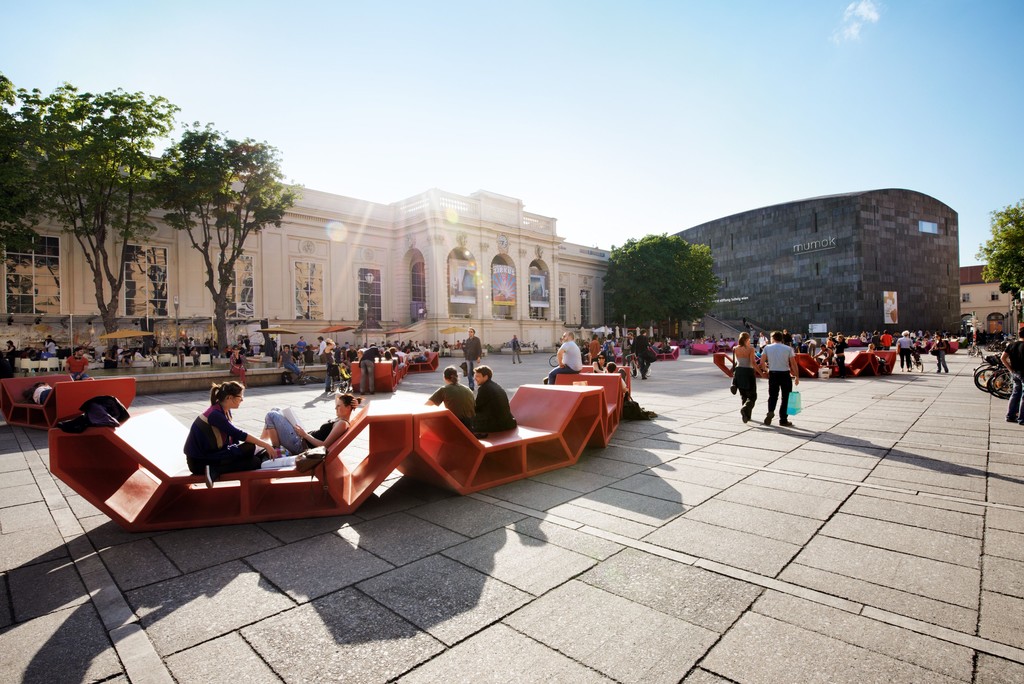
The inventive public seating area in the Museumsquartier courtyard
As a little reward for all your patience I'll send you to the Mariahilfer Straße as your last stop. Vienna's most popular shopping street is (almost) entirely a pedestrian street. The "Mahü" as the locals call it ends right where we start our shopping spree - at the Museumsquartier.
Tour 3: Around the Ring
Votivkirche - University - Burgtheater - Rathausplatz - Parliament Building - Volkstheater
This final tour does not actually include a lot of walking - if you were to just rush from start to finish without stopping to take a look at any of the landmarks, you would be done in ten to fifteen minutes. However, if you take your time to look at everything in this small part of the city closely, your city walk might take somewhat longer.
To get to our starting point, the Votivkirche, take the U2 to Schottentor and follow the signage to the right exit. The name of this church is already telling - it was built as a votive offering (lat. vovere - to pledge) to express gratitude for the rescue from a precarious situation. To be exact, it was an offering of gratitude by the people of the monarchy for Emperor Franz Joseph surviving an attempt on his life in 1853. But not everything about this church is as it seems: While the architecture seems gothic (i. e. from medieval times), the church was actually built in the second half of the 19th century. Overall, this church is interesting to explore, not only because of its stunning architecture, but also its historical significance for Vienna.

Main Organ and the Round Stained Glass Windows of the Votivkirche
You leave the church behind and walk across the Sigmund-Freud-Platz to the right and straight towards the Main building of the University of Vienna. This building was also erected towards the end of the 19th century and its architecture is based on the style of Italian Renaissance buildings - a homage to Italy's old and renowned universities. You can enter the building if you like - it is beautiful! You will quickly reach an elegant courtyard, the so called Arkadenhof, which is a wonderful place to enjoy the sun in summer. I winter on the the other hand, the inside of the building will give you somewhat of a Hogwarts-feeling.
Our next stop along the Ring - just five minutes from the university - is the Burgtheater, the biggest German-language institution of spoken theatre and the second oldest in Europe. There are guided tours through the building every day, which I recommend since the building is even more magnificent from the inside. For example, a guided tour will let you take a look at young Gustav Klimt's beautiful ceiling mural.
Right across from the Burgtheater, you can now already spot the Rathausplatz and the Rathaus (town hall) itself. This place is great not only because of the charming neo-Gothic building, but also because there are special events on the Rathausplatz organised by the city of Vienna year-round. In November and December for example you can go for a stroll through the Christkindlmarkt, Vienna's famous Christmas market, and enjoy some punch and mulled wine. In January, the square turns into an ice skating rink and if you are travelling in summer, you might be just in time for the Vienna Festival (Wiener Festwochen). Here you can watch live opera, theatre and dance productions or enjoy some street food from one of the many food stands that accompany the festival and offer delicious snacks from all over the world.
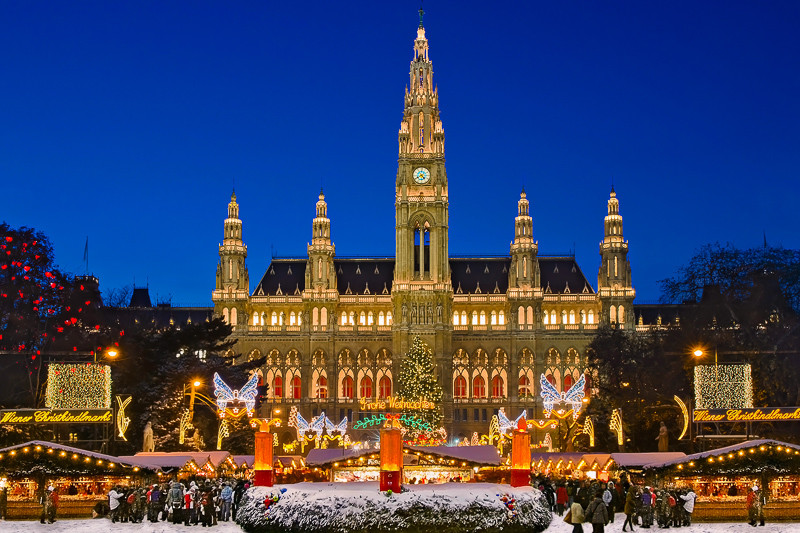
Our next stop is the Austrian Parliament, which is right next to the Rathaus. It's a textbook example of neoclassical art; at first glance you may think you're standing in front of an ancient greek temple. In front of the Parliament Building, the Greek goddess of wisdom, strategy and battle is immortalised in the Pallas Athene Fountain. Since Athena is not inside the parliament but in front and facing away from the building, the people of Austria often joke that there evidently isn't any wisdom in the parliament at all.
Last but not least we make our way to the Volkstheater, which is also close by, just one street over. This theatre is one of Europe's most famous stages as well, so every theatre enthusiast among you should try to get their hands on some tickets for at least one of the two theatres on this tour. Originally, this theatre - as opposed to the Burgtheater, which was reserved for the imperial court - was open to the masses and the general public. Thankfully, you don't have to consider your family background when choosing a theatre nowadays!
And that's all from me. I tried focusing the tours primarily on the city center, but don't forget that there's a lot to see in the periphery as well! Schönbrunn Palace, Prater and the Donauinsel are just some examples of places that are well-worth visiting. So while you are in Vienna, use the chance to take the U-Bahn to one of these more far-off destinations. Vienna has a lot to offer, city center and periphery each have their beautiful corners.
Photo gallery
Content available in other languages
Want to have your own Erasmus blog?
If you are experiencing living abroad, you're an avid traveller or want to promote the city where you live... create your own blog and share your adventures!
I want to create my Erasmus blog! →
























Comments (0 comments)